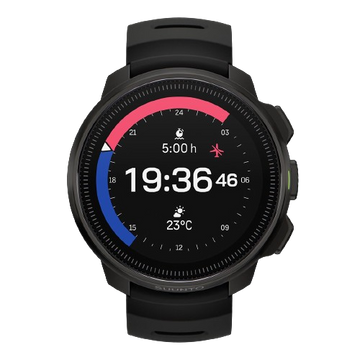Heart rate variability (HRV) is a helpful metric for endurance athletes. Read on to learn why there’s a buzz around it and how to use Suunto to track heart rate variability.
First, it is good to understand what Heart Rate Variability (HRV) is. As an example, when your heart rate is 60 beats per minute, each interval is not exactly one second. There’s a slight variation in the duration between the beats. HRV is a quantitative measure of the variation in the time intervals between consecutive heartbeats.
The interesting point with HRV is that it serves as an indicator of the balance within the autonomic nervous system and offers valuable insights into an individual's overall health and stress levels. More variation generally means the parasympathetic nervous system is doing its job as a regulator.
Various factors, such as heavy training, mental stress, or the presence of an illness like the flu, can influence HRV readings.
Suunto Race, Suunto Vertical and Suunto 9 Peak Pro GPS watches can track your HRV during your sleep. Nighttime measurement is a reliable and easy way to gather comparable HRV data. Continuous HRV monitoring allows for the calculation of the average Root Mean Square of Successive Differences (RMSSD) value, a commonly employed metric for quantifying HRV.
You can see the HRV data anytime as a mini widget in your watch and in the Suunto app’s Training zone.

Your recovery status is evaluated by comparing your 7-day average HRV with your normal range.
Interpreting HRV Data
Heart rate variability is highly individual. As said, higher HRV values generally indicate better autonomic balance, although the assessment should always be contextualized within an individual's normal range.
At Suunto, we define your normal range over a 60-day period and then compare your rolling seven-day average with that baseline. A minimum of 14 measurements needs to be gathered over the 60 days to define your normal range. For the seven-day average, a minimum of three measurements is needed. So, if you are new to measuring HRV with Suunto, you will have HRV data even after the first night, but the data will get more defined as more data is gathered.
By comparing the long-term values with short-term trend, you will get an understanding of load and stress you are putting on your body.
If your HRV values consistently fall below your normal range, it is an indication of a compromised recovery state. This could be caused by chronic stress, inadequate sleep, overtraining, or an underlying health condition.
It is normal that after a very hard effort or a race, your HRV drops below the normal range for a day or two.
If your HRV rises abnormally high (above a certain standard deviation) within a day or a few days, the app indicates with a yellow or red that you are likely experiencing abnormal amounts of recovery (parasympathetic nervous system activity). This is often in response to accumulated amounts of stress.

Suunto app visually represents your HRV recovery status as a bar indicator, offering insights into your recovery.
How to use HRV in daily training with Suunto
- Suunto utilizes overnight measurements to capture HRV data. To obtain HRV measurements, it is necessary to wear the watch while sleeping and ensure that sleep-tracking functionality is activated.
- Sync your watch regularly with the Suunto app to see the latest data.
- Compare your HRV measurements with your training load. Look for patterns and relationships between your HRV values and the intensity or volume of your workouts. This can help identify how your body responds to different training stimuli.
- Compare your HRV values with your resting heart rate. Generally low resting heart rate and a high heart rate variability are good indicators of sufficient recovery.
- If your HRV readings indicate a decrease or significant deviation from your baseline, it may suggest a higher level of physiological stress or insufficient recovery. Consider modifying your training plan by reducing the intensity or volume of your workouts to allow for adequate recovery.
- Use HRV as a guide to schedule regular recovery days or lighter training sessions when your HRV values indicate a need for more rest.
- Remember that HRV can vary between individuals, so it is essential to understand your own personal baseline and response to training. It's important to note that with HRV it's good to look at other factors that impact recovery state such as training stress balance, sleep volume and changes in feeling.
Heart rate variability measurement is available in Suunto Vertical, Suunto Race and Suunto 9 Peak Pro GPS watches.
































































































